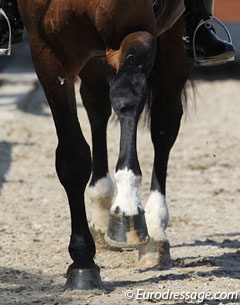
There are several types of orthopedic diseases that can occur in foals and young horses. Among the most recognized are juvenile osteoarthritis, which causes joints to degenerate; angular limb deformities
, which make a foal look knock-kneed or bow-legged; and a condition called osteochondrosis (OC).
OC is the most common equine juvenile orthopedic disease, and is characterized by abnormal cartilage and bone formation in a horse's joint as it grows. Horses with this problem can experience stiffness, lameness, and joint effusion, which can make the joints looks puffy, including the fetlock, hock, and stifle. These horses may be at more risk for developing osteoarthritis as they age if the osteochondrosis lesions are not treated.
Horses' legs normally grow when the soft cartilage at the end of their long bones, known as growth plates, hardens into bone and gradually increases the length of the leg. For horses with OC, the cartilage at the top of certain growth plates does not undergo the normal hardening process and may break down. Extra fluid can form in the affected joints due to the inflammation caused by the abnormal cartilage. Osteochondrosis can also present as cracks in the cartilage and cysts in the underlying subchondral bone. Sometimes, when abnormal ossification or hardening of the cartilage occurs, bone and cartilage fragments may break off from the main bone and float free in the joint fluid, referred to as "joint mice."
Read the Complete Article at Horsetalk.co.nz
Related Link
Eurodressage Veterinary News